Sphinginae subfamily
Sphingini tribe:
 |
Agrius cingulata,
Pink-spotted hawkmoth,
BAMONA: Tangipahoa; St Tammany:
Strong migrant; adults nectar from
deep-throated flowers including moonflower (Calonyction aculeatum),
morning glory (Convolvulus), honey suckle (Lonicera), petunia (Petunia species).
|
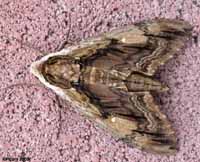 |
Ceratomia amyntor
WO,
the Elm Sphinx or Four-horned Sphinx: Brown with dark brown and white markings including white costal area near wing base, dark streaks along veins,
white spot in cell.
Elm (Ulmus), birch (Betula), basswood (Tilia), cherry (Prunus). |
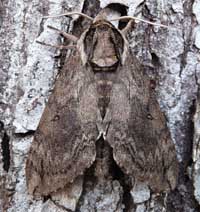 |
The upperside of the forewing is yellowish brown with no white markings, but there are indistinct black lines and dashes. The cell spot is gray with a black outline. The larvae feed in large groups and are much more
spectacular than the moths.
Catalpa is the larval host. |
 |
Ceratomia hageni
WO,
Hagen's Sphinx or Osage Orange Sphinx
The upperside of the forewing is gray with a green tint and has dark
indistinct wavy lines, and pale gray patches at the wing tip and
along the costa. |
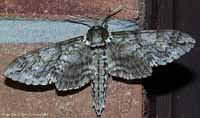 |
Ceratomia undulosa
BAMONA: St James, Waved Sphinx:
Pale (sometmes dark) brownish gray with wavy black and white lines and black-outlined white cell spot. Hindwing is gray with diffuse darker bands. |
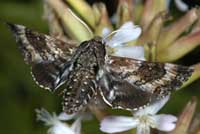 |
Dolba hyloeus
WO, Pawpaw Sphinx:
The upperside of the forewing is dark brown with a dusting of white
scales. Some moths have patches of reddish or yellowish brown on the
wings.
|
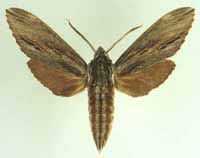 |
Isoparce cupressi
WO, Cypress or Baldcypress Sphinx:
Rare Cypress Sphinx, flies in Cypress swamps in Georgia (specimen type locality), and from Maryland to Texas.
It has been reported in Mexico.
|
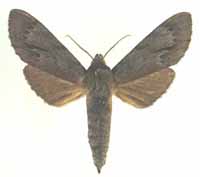 |
Lapara phaeobrachycerous
BAMONA: Tangipahoa; St Tammany, Pine Sphinx:
If you have pines, you might have this species.
slight possibility
|
 |
Lapara coniferarum
BAMONA: Tangipahoa; St Tammany, outhern Pine Sphinx:
Gray with two (sometimes one or three) black dashes near the wing center; other markings are usually diffuse.
The upperside of the hindwing is a uniform brown-gray.
If you've got pines, this species is likely present.
|
 |
Lintneria eremitus
WO, Hermit Sphinx:
Gray-brown with wavy lines,
black dashes, one or two small white spots near center of
costa. Beebalm (Monarda), mints (Mentha),
bugleweed (Lycopis), sage (Salvia).
|
 |
Manduca jasminearum
WO, Ash Sphinx:
Gray to grayish brown with black line
running from middle of costa to middle of outer
margin; line may be broken near margin. Splash of
brown around cell spot.
|
 |
I suspect if you grow tomatoes, you are likely to encounter Manduca quinquemaculata.
|
 |
Manduca rustica
WO, Rustic Sphinx:
Three large yellow spots
on each side of abdomen.
Yellowish brown to deep chocolate brown with dusting of white
scales and zigzagged black and white lines.
|
 |
Manduca sexta
BAMONA: St Tammany, Carolina Sphinx:
If you grow tomatoes, you have probably encountered Manduca sexta
in the larval stage.
Larvae get very large and can strip a tomato plant.
|
Manduca sexta, Greenwell Springs, East Baton Rouge, Frannie Mathews.
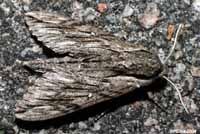 |
Paratrea plebeja
WO, Plebeian Sphinx: Gray with indistinct black and
white markings. There is a series of black dashes
from the base to the tip, and a small white cell spot.
|
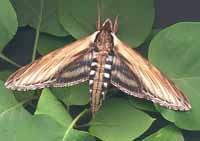 |
The lower forewings are predominantly brownish-yellow with a fairly
wide dark bar along the inner margin. At rest the wings hug the body,
giving the moth a long slender look.
|
Smerinthini Tribe:
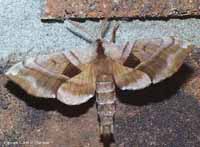 |
Amorpha juglandis
WO, Walnut Sphinx:
Highly variable; sometimes all one color or may have several colors, ranging from pale to
dark brown, may have white or pink tinge. Patterns range from
faint to pronounced.
See the file for the female; she is different.
|
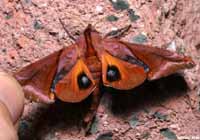 |
Paonias astylus
WO, Huckleberry Sphinx:
Paonias astylus flies from March-September in Florida and from
April-September in Louisiana. There is one brood northward from
June-August.
This appears to be an uncommon species.
|
 |
Paonias excaecata
WO,
Blinded Sphinx:
Named for the dull grey-blue spot (minus dark pupil) in hindwing,
has a wide distribution in eastern United States.
I regularly see them on Prince Edward Island; they are reported
as far south as Florida. |
 |
Paonias myops WO, Small-eyed Sphinx:
Named for the small eye-spot in the hindwing, this moth has a wide
distribution and is probably common in your parish.
I regularly see them on Prince Edward Island, and they are reported
as far south as Florida.
|
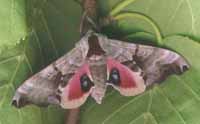 |
Smerinthus jamaicensis
WO, Twin-spotted Sphinx:
This moth is widely distributed and fairly common.
Along the East Coast, it flies from P.E.I. to Florida. |
Macroglossinae subfamily
Dilophonotini tribe:
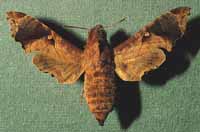
|
Enyo lugubris, Mournful Sphinx,
BAMONA: St Tammany:
Body/wings dark brown. FW: large black
patch covering most of outer half of wing. Pale
tan cell spot (dark inner pupil), and fairly straight median line
to the inside of the cell spot.
|
 |
Erinnyis obscura, Obscure Sphinx,
WO:
During the night adults nectar at flowers, including bouncing bet
(Saponaria officinalis) and Asystasia gangetica beginning at dusk.
July and August are flight times in the southern states. remote possibility
|
See Hemaris comparison to help distinguish
the next two species.
 |
Hemaris thysbe
BAMONA: St Tammany, Hummingbird Clearwing:
It is not difficult to see why many gardeners would mistake an
Hemaris thysbe moth for a small hummingbird as it hovers,
sipping nectar from flowers through a long feeding tube.
|
 |
Hemaris diffinis BAMONA: Tangipahoa, Snowberry Clearwing/Bumblebee Moth:
Adults mimic bumblebees; quite variable. Wings basically clear, with dark brown to
brownish-orange veins, bases, edges. Thorax: golden-brown to
dark greenish-brown. Abdomen tends to be dark (black) with 1-2
yellow segments before tip.
|
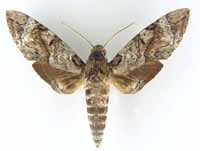 |
Pseudosphinx tetrio, Tetrio Sphinx,
WO:
Dark brown with a dark spot at the
base of the costa and blurry gray and white markings. The upperside
of the hindwing is dark brown with white along the inner margin, and
the lower half of the outer margin.
|
Philampelini tribe:
 |
Eumorpha achemon
WO,
Achemon Sphinx:
Larvae get large and feed on grape vines and Virginia creeper.
Note the differences between this moth and the Pandorus Sphinx. |
 |
Eumorpha fasciatus
JF/BAMONA: St Tammany, Banded Sphinx:
Dark pinkish brown. Each forewing: lighter brown band along costa, sharp pinkish white bands and
streaks. Larvae feed upon primrose-willow, Ludwigia (water primrose),
other plants in evening primrose family.
|
Eumorpha fasciatus, Tangipahoa, May 12, 2018, Jackie Finch
 |
Eumorpha intermedia
BAMONA: St James, Intermediate Sphinx:
The Intermediate Sphinx Moth, (Eumorpha intermedia), (Wing span: 3 9/16 - 3 7/8 inches (9 - 9.8 cm)), flies in lower austral and subtropical lowlands in North Carolina, Florida,
Mississippi, Louisiana, and South Texas. posibility
|
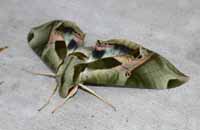 |
Eumorpha pandorus
WO, Pandorus Sphinx:
If you have Grape or Virginia Creeper nearby, then you probably have
this species.
I often get asked to identify larvae from areas not
previously reported. |
Macroglossini tribe:
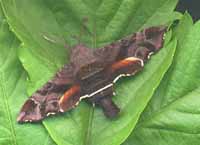 |
Amphion floridensis
WO, Nessus Sphinix:
This day flier is widely distributed. If you have Virginia Creeper, you
probably have the Nessus Sphinx. Two bright, distinct, narrow yellow
bands are often visible on the abdomen.
|
 |
Darapsa choerilus
WO, Azalea Sphinx:
The lower wings of this hawkmoth are a solid brownish-orange,
matching the body colour.
You will often see this species listed as Darapsa pholus,
especially in older literature. |
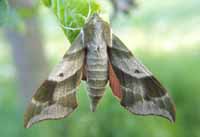 |
Darapsa myron WO, Virginia Creeper Sphinx/Grapevine Sphinx:
If you have the foodplants indicated in the common names, you probably have this
species nearby. The lower wings are orange. |
 |
Darapsa versicolor
WO,
Hydrangea Sphinx:
If you have hydrangea growing near a stream, then you might have the
Hydrangea Sphinx.
|
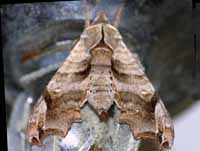 |
Deidamia inscriptum
WO,
Lettered Sphinx:
Fw outer margin deeply scalloped.
The upperside is light brown with dark brown markings.
Small black and white spot near tip.
Grape (Vitis), ampelopsis (Ampelopsis), Virginia creeper (Parthenocissus) all serve as larval hosts.
|
 |
Hyles lineata WO, White-lined Sphinx:
This species has
strong migrating tendancies from much further south.
There are records from New Hampshire and Maine.
|
 |
Proserpinus guarae
WO,
Proud Sphinx:
Rare and possibly endangered Proud Sphinx flies from Texas and
Louisiana east to northern Florida, north to Alabama, Missouri,
northern Georgia, and South Carolina. slight possibility
|
 |
This moth is very much under reported across the United States. It
is a rapid day flier so is probably not in too many collections.
Grape is a popular larval host.
|
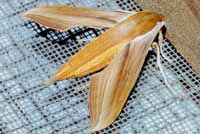 |
Xylophanes tersa BAMONA: St Tammany,
the Tersa Sphinx
This moth is much more common to the south. It is a strong migrant,
however, and may establish itself in Mobile County periodically.
|
|
|


